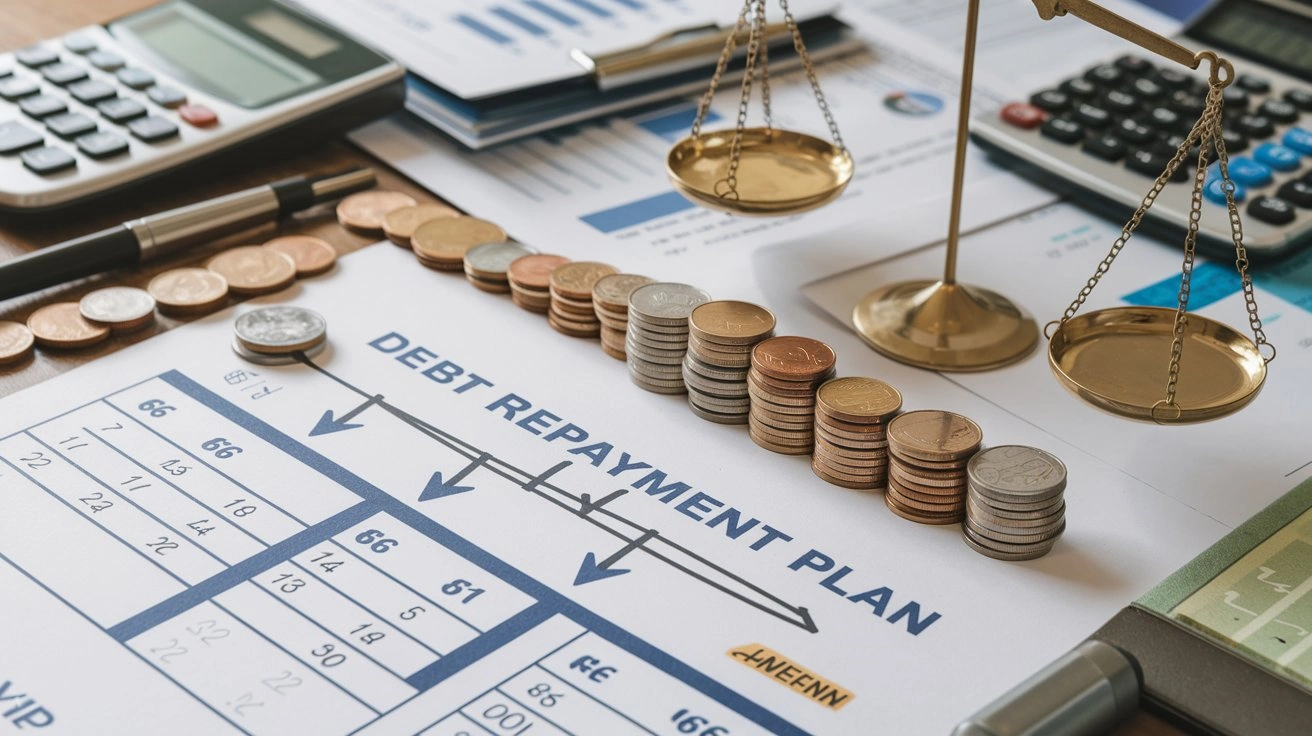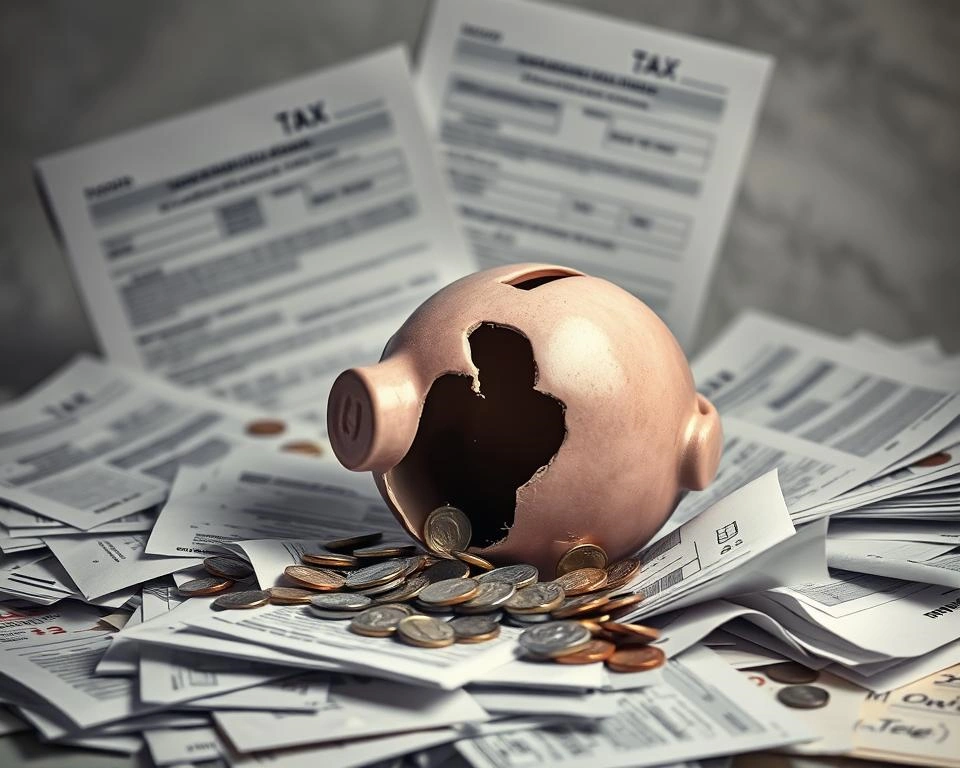Staggering Fact: Americans owe over $16 trillion in debt, with an average household debt of $155,622. But, with the right plan and determination, you can break free from debt. This guide will help you create a debt repayment plan that fits your situation. It will aid you in achieving your goal of living debt-free.
Tally Up Your Debts
The first step in making a debt repayment plan is to review your current debts carefully. You need to create a list of debts, gather necessary information, and organize your debt details. This helps you understand your financial situation clearly.
List All Your Debts
Start by listing all your outstanding debts. This includes credit card balances, student loans, auto loans, personal loans, and medical bills. For each debt, note the name of the lender, the total amount owed, the interest rate, and the minimum monthly payment. This gives you a clear view of your debt situation.
Gather Necessary Information
After listing your debts, gather the necessary details for each one. Get the latest statements, account numbers, and contact information for your lenders. Having this info ready is key for devising a debt repayment strategy and talking to your creditors.

“The first step to financial freedom is understanding your current debt situation.”
By creating a list of debts, gathering debt details, and organizing your debt information, you’re on the path to a solid debt repayment plan. This plan will help you achieve long-term financial success.
Devise a Strategy
When tackling debt, you have a few options. The avalanche and snowball methods are two popular choices. Each has its own benefits, so pick the one that fits your financial situation best.
Avalanche Debt Payoff Method
The avalanche method targets the debt with the highest interest rate first. This saves you money over time by focusing on the most expensive debts. After paying off the highest-interest debt, you move on to the next one.
Snowball Debt Payoff Method
The snowball method, on the other hand, focuses on the smallest debt first. This approach gives you a sense of accomplishment as you clear each debt. It might not save as much interest, but it’s motivating to see your debts go away.
Choosing either the debt repayment strategies means making minimum payments on all debts. Then, use extra money for the top priority. This approach helps you make steady progress towards becoming debt-free.

Prioritize Your Debts
Organizing your debt repayment is a big step towards financial freedom. Think about interest rate, balance, and impact on your credit or living situation when prioritizing. A debt payment schedule helps you stay on track and work towards being debt-free.
Begin by listing all your debts in order of priority. It’s wise to start with debts that have the highest interest rates. These are costing you the most money. But, if a debt threatens your housing or credit score, tackle it first, even if the interest rate is lower.
- Identify your debts with the highest interest rates.
- Determine the minimum payment required for each debt.
- Allocate any additional funds towards the debt with the highest interest rate.
- Once the highest-interest debt is paid off, roll those payments to the next highest-interest debt.
- Repeat this process until all your debts are paid off.
By prioritizing your debt payments and creating a structured repayment plan, you can make steady progress towards becoming debt-free. Remember, staying organized and consistent is key to achieving your financial goals.
“The secret of getting ahead is getting started.” – Mark Twain
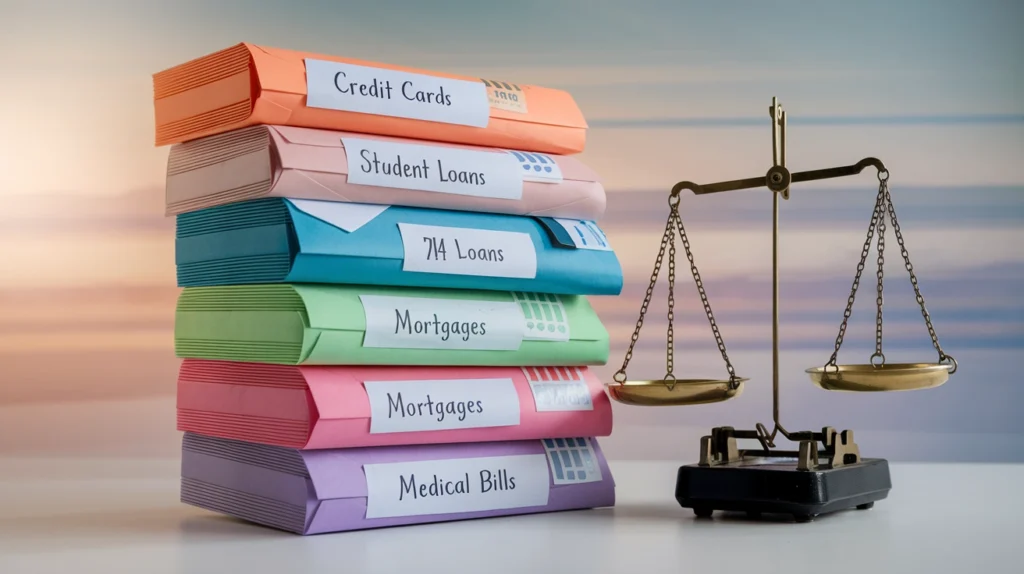
Focus on One Debt at a Time
When you’re working to pay off your debts, it’s smart to tackle one at a time. This method can really help you move forward and save money on interest.
By focusing on paying more towards the principal of one debt, you’ll save on interest. This approach lets you make quick progress and see results. Instead of trying to tackle many debts at once, you can make a big impact.
Think about using the avalanche debt payoff method or the snowball debt payoff method. Both help you focus on one debt at a time. But they differ in how you order your debts.
“Focusing on one debt at a time is the most effective way to become debt-free. It allows you to make significant progress and see the impact of your efforts.”
Choosing a method, the key is to put all your effort into paying more towards the principal of one debt. This not only saves you on interest but also gives you a feeling of accomplishment as you clear your debts one by one.
Remember, becoming debt-free takes discipline and focus. By focusing on one debt at a time, you’ll be able to pay more towards the principal and save on interest. This way, you’ll reach your financial goals more efficiently.

Avoid Accumulating More Debt
When you’re paying off debts, it’s key to not take on more. This means closing or freezing your credit cards to stop new spending. But, closing a card can hurt your credit score by lowering your credit use ratio. If you can’t close them, many issuers let you freeze your card temporarily.
It’s also vital to watch your credit use. Avoiding new debt accumulation and monitoring credit utilization are crucial to keep your debt from growing while you pay it off.
- Closing or freezing credit cards can stop new debt, but it might lower your credit score.
- Keeping an eye on your credit use helps you stay on track and make smart card choices.
- Stay careful with your credit and spending to keep your debt repayment plan working.
“The key to avoiding new debt is to be proactive and disciplined in your financial management. It may require some sacrifices, but the long-term benefits of a debt-free life are well worth the effort.”

Slash Expenses and Increase Income
To free up more money for debt repayment, you need to cut expenses and boost income. By being strategic, you can use more funds to pay off debts.
Cut Back on Expenses
Start by making a detailed budget to track your spending. Look for ways to cut costs, like housing, transportation, and fun money. Try to reduce expenses by negotiating bills, finding cheaper housing, or choosing a fuel-efficient car.
- Review your monthly bills and see where you can cut costs
- Consider downsizing your living space or finding a more affordable rental
- Explore ways to save on transportation, such as carpooling or using public transit
Find Ways to Earn More
Also, look for ways to increase your income. This could mean asking for a raise, starting a side hustle, or freelancing. Any extra money should go straight to debt repayment.
- Speak with your employer about the possibility of a raise or promotion
- Explore side hustles that align with your skills and interests
- Consider freelancing or taking on contract work in your field
“When it comes to debt, the more you can do to create a budget and find ways to earn extra income, the faster you’ll be able to pay it off and regain control of your financial future.”

By cutting expenses and increasing income, you’re on the path to a solid debt repayment plan. Every dollar you save or earn gets you closer to financial freedom.
How to Create a Debt Repayment Plan That Works
To make a good debt repayment plan, you need to know your finances well. First, list all your debts and get the details like interest rates and balances. This helps you see what you owe and plan how to pay it off.
Then, decide which debts to pay off first. You can choose the avalanche method or the snowball method. The avalanche method targets high-interest debts first. The snowball method starts with the smallest balances. The important thing is to pay one debt at a time and put as much money as you can towards it.
It’s also key to make a realistic budget. Track your income and expenses, then use any extra money for debt payments. Try not to get more debt while you’re paying off what you already have.
Remember, making a debt repayment plan is a long-term effort. Keep an eye on your credit score and change your plan if needed. With a solid plan and discipline, you can become debt-free.
Monitor Your Credit Score
As you work on paying off debt, watching your credit score is key. It gives you insights and helps you stay on track. By checking your credit reports often and using credit monitoring tools, you can make sure your payments are reported right. This way, you can fix any problems quickly.
Order Credit Reports
Getting your credit reports from Equifax, Experian, and TransUnion is important. These reports show if there are mistakes in your credit history. By getting your reports often, you can keep up with your credit score and make sure your debt payments are counted.
Use Credit Monitoring Services
Free credit monitoring tools also help a lot. They send alerts when your credit changes. This could be new accounts, changes in how much you owe, or odd activity. Using these tools helps you manage your credit well while paying off debt.
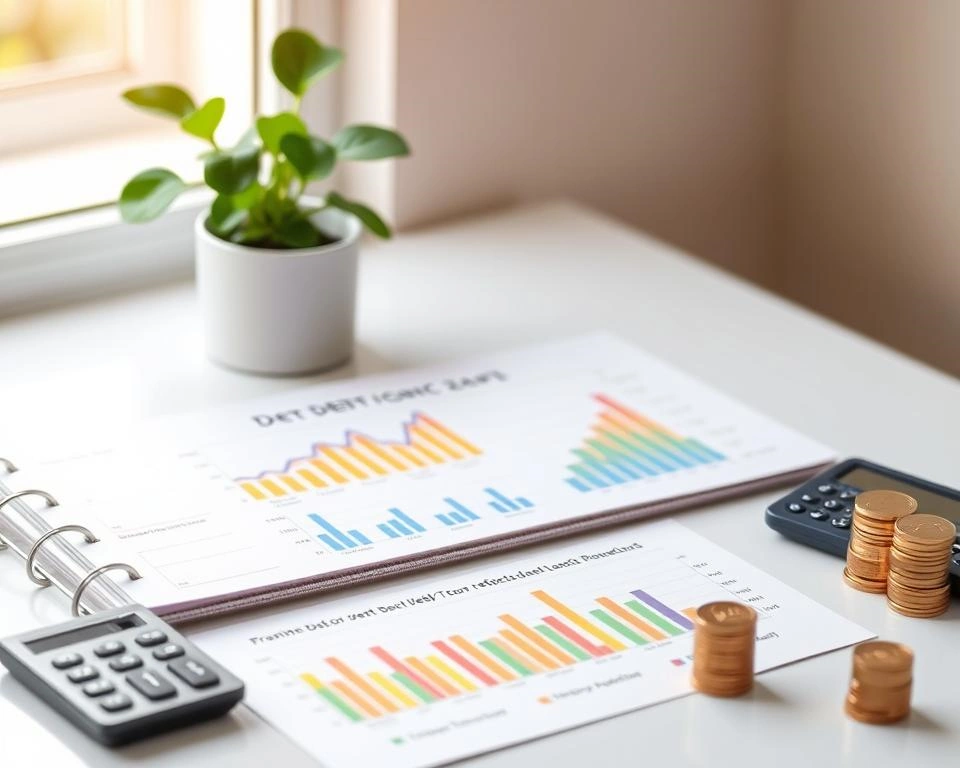
“Monitoring your credit score is like keeping a pulse on your financial health. It’s a crucial step in ensuring your debt repayment efforts are paying off.”
Creating a good debt repayment plan is a journey. It needs organization, discipline, and smart thinking. By tallying up your debts, devising a repayment strategy, prioritizing your payments, and actively monitoring your progress, you can control your financial future. This way, you can become debt-free.
Keeping up with this financial discipline is crucial. It helps you pay off debts now and prepares you for the future. As you go through this, remember that achieving financial freedom is possible, step by step.
“The secret to getting ahead is getting started.” – Mark Twain
By following this guide, you can make a debt repayment plan that fits your needs. Start the journey, stay focused, and celebrate your wins. With hard work and smart strategies, you can overcome debt. This will open doors to a future with financial security and possibilities.
- Maintain financial discipline throughout the debt repayment process
- Stay organized and vigilant in monitoring your progress
- Celebrate your achievements and milestones along the way
The journey to financial freedom is not simple, but it’s worth it. Take on the challenge, stay dedicated, and see your financial world change one step at a time.

Debt Consolidation Options
Struggling with multiple debts can be overwhelming. The idea of simplifying payments and saving on interest is very appealing. Debt consolidation options, like loans and credit cards, can help you manage your finances better.
Debt Consolidation Loans
A debt consolidation loan combines several debts into one, often at a lower interest rate. This makes managing payments easier and can save you money. To get a loan, you need good credit and a steady income. Compare different lenders to find the best deal.
Balance Transfer Credit Cards
Balance transfer credit cards offer 0% APR for a while, letting you pay off debt without interest. This is a great strategy, but you must pay off the balance before the offer ends. Watch out for fees and make sure you can afford the payments to avoid more debt.
Choosing between a loan or a credit card depends on your financial situation. Both can simplify payments and save money. Make sure to understand the terms and fees to meet your financial goals.
“Debt consolidation can be a game-changer, but it’s important to understand the pros and cons before making a decision.”
Negotiating with Creditors
Reaching out to your creditors can help manage your debt. Lenders often want to work with you to pay off the debt. You might get lower interest rates, reduced balances, or custom payment plans.
This process takes patience and persistence. But it can save you money and find an agreement that works for both sides.
For debts with collection agencies, you can negotiate too. Talk openly and suggest solutions that work for you. This way, you might find a deal that helps you pay off your debt.
Dealing with these negotiations can be tough. But being cooperative and looking for solutions can help. Remember, creditors usually want to work with you. So, don’t be afraid to speak up and find the best options for you.
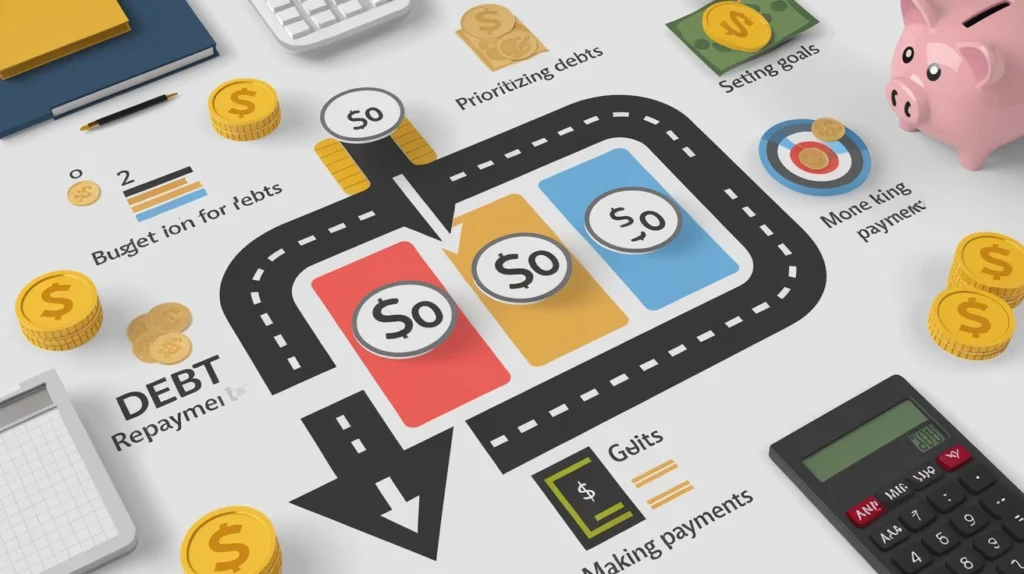
30 expert tips to create a debt repayment plan that works:
1. Assess Your Financial Situation
- Start by listing all your debts, including balances, interest rates, and minimum monthly payments.
2. Create a Budget
- Allocate your income toward essential expenses, debt payments, and savings. A budget is your roadmap.
3. Prioritize High-Interest Debts
- Focus on paying off debts with the highest interest rates first (debt avalanche method) to save money on interest.
4. Consider the Debt Snowball Method
- Pay off the smallest debts first for quick wins, boosting motivation to tackle larger ones.
5. Consolidate Your Debts
- Combine multiple debts into one loan with a lower interest rate for simpler management.
6. Negotiate Lower Interest Rates
- Call your creditors to ask for lower rates. A good credit history can increase your chances of approval.
7. Transfer Balances
- Use a 0% APR balance transfer credit card to temporarily halt interest accrual and focus on principal repayment.
8. Pay More Than the Minimum
- Always pay more than the minimum payment to reduce the principal faster and save on interest.
9. Automate Your Payments
- Set up automatic payments to avoid late fees and ensure consistent progress.
10. Cut Unnecessary Expenses
- Identify areas to reduce spending and redirect those funds toward your debt.
11. Track Your Progress
- Use apps or spreadsheets to monitor your repayment journey and stay motivated.
12. Use Windfalls Wisely
- Direct bonuses, tax refunds, or unexpected income toward debt repayment.
13. Avoid New Debt
- Refrain from using credit cards or taking on new loans while repaying existing debt.
14. Establish an Emergency Fund
- Save a small emergency fund (e.g., $1,000) to avoid relying on credit for unexpected expenses.
15. Seek Professional Advice
- Consult a credit counselor or financial advisor for tailored strategies and guidance.
16. Prioritize Needs Over Wants
- Differentiate between essential expenses and luxuries to free up money for debt payments.
17. Leverage Side Hustles
- Use income from freelance work or part-time jobs to make extra payments.
18. Sell Unused Items
- Declutter and sell items online or through garage sales to generate additional funds.
19. Review Statements Regularly
- Check your credit card and loan statements to spot any errors or fraudulent charges.
20. Set Specific Goals
- Break your debt into smaller goals (e.g., paying off $5,000 in six months) for a clear direction.
21. Choose Biweekly Payments
- Split your monthly payment in two, making 13 full payments annually instead of 12.
22. Stay Accountable
- Share your goals with a trusted friend or join a support group to stay on track.
23. Use the Envelope System
- Allocate cash for categories like groceries or entertainment to prevent overspending.
24. Celebrate Milestones
- Reward yourself for reaching major milestones, but avoid costly celebrations.
25. Consider Refinancing
- Refinance loans like mortgages or car loans to secure lower interest rates.
26. Avoid Payday Loans
- These high-interest loans can worsen your financial situation and lead to a debt cycle.
27. Read the Fine Print
- Understand terms and conditions of your debts to avoid hidden fees and penalties.
28. Use Technology
- Debt payoff calculators, budgeting apps, and reminders can help you stay organized.
29. Adjust When Necessary
- Life changes. Be flexible and adjust your repayment plan as needed to stay realistic.
30. Stay Motivated
- Remind yourself of the end goal: financial freedom. Visualize the benefits of a debt-free life.
Key Takeaways
- Develop a comprehensive understanding of your debts by listing them and gathering necessary information.
- Devise a debt repayment strategy, such as the Avalanche or Snowball method, to prioritize your debts effectively.
- Focus on paying off one debt at a time to build momentum and stay motivated.
- Reduce expenses and increase income to allocate more funds towards debt repayment.
- Monitor your credit score and negotiate with creditors to improve your debt management plan.
Source Links
- How To Set Up A Debt Plan & Stick To It | Bankrate – https://www.bankrate.com/personal-finance/debt/how-to-stick-to-debt-payoff-plan/
- Ultimate Guide to Creating Your Own DIY Debt Management Plan | MMI – https://www.moneymanagement.org/budget-guides/create-a-diy-debt-repayment-program
- 5 Steps to Setting Up a Debt Repayment Plan – Experian – https://www.experian.com/blogs/ask-experian/how-to-set-up-debt-repayment-plan/

